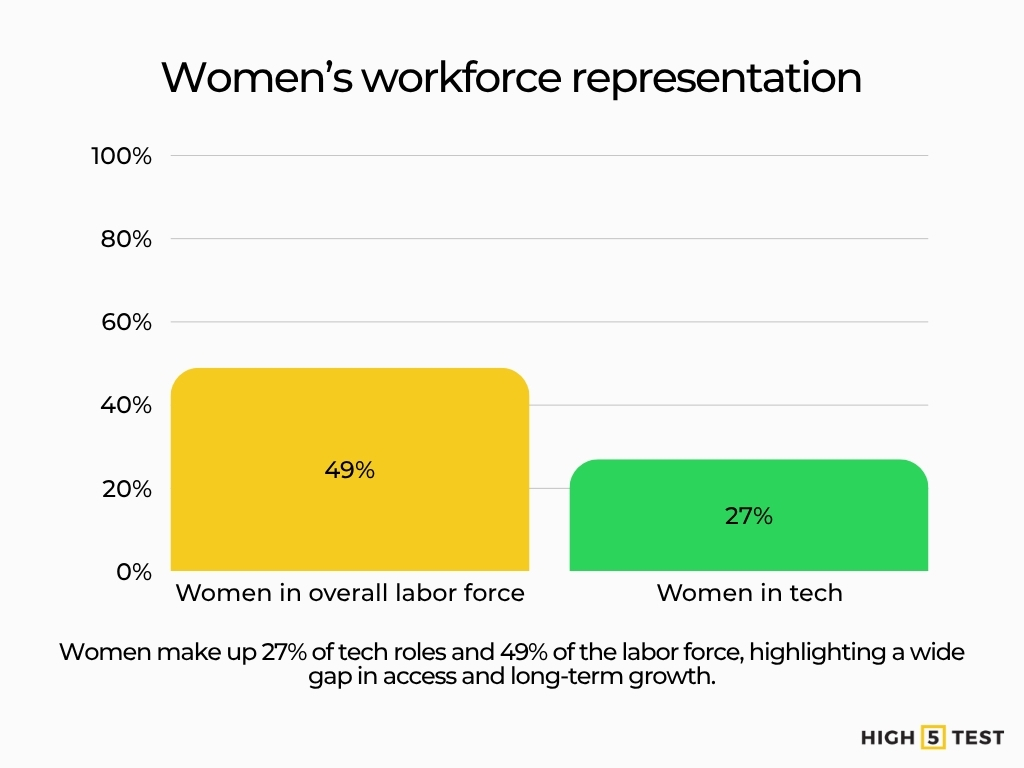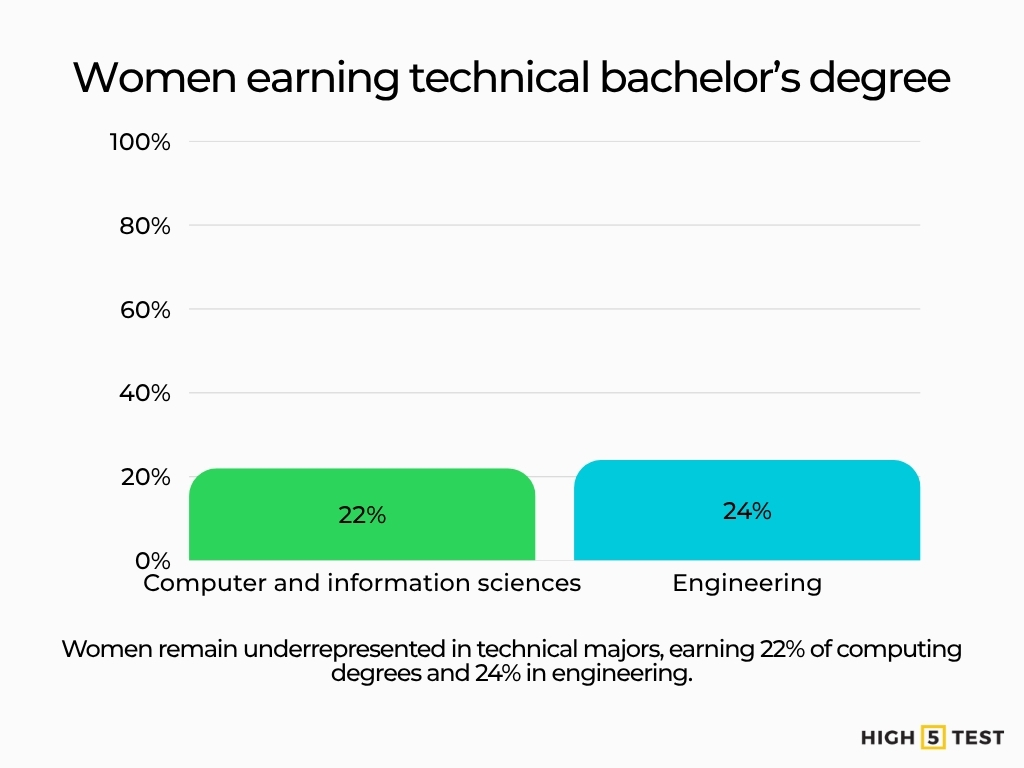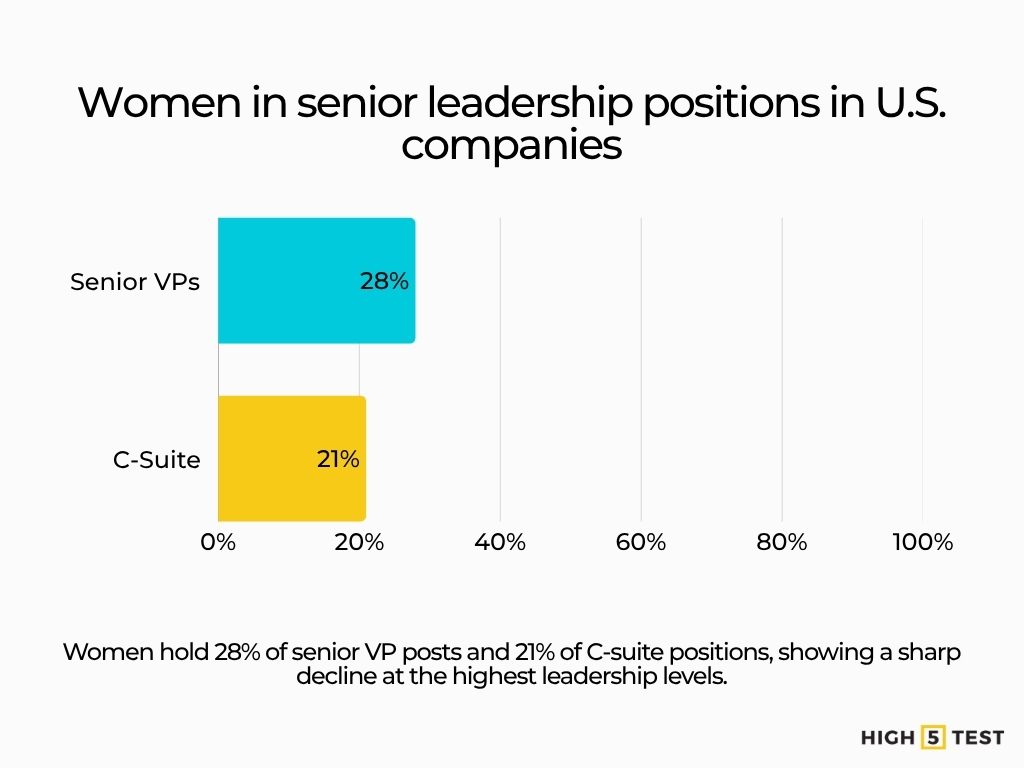The representation of women in technology remains one of the most critical benchmarks of progress in the digital economy. As the United States enters 2025, new data from the Bureau of Labor Statistics (BLS), National Science Foundation (NSF), and leading research institutions reveal both progress and persistent disparities across employment, pay, education, and leadership.
Below is a comprehensive analysis of the most recent figures on women in tech, based on 2024 and early 2025 data, and what they reveal about the state of gender diversity in the American technology sector.
10 most interesting women in tech statistics in the U.S. (2024-2025)
- Women held ≈ 27% of all U.S. technology occupations, despite making up ~49% of the overall labor force.
- Women account for ~35% of all STEM workers in the U.S., but only ~21.3% of those with a bachelor’s degree in computer and information sciences.
- Women hold 26% of computing roles and only 16% of engineering roles.
- Women earned 22% of bachelor’s degrees in computer & information sciences and 24% in engineering.
- The share of women earning computing degrees has remained stagnant at ~25-26% since 2016.
- In U.S. companies overall, women hold 28% of senior vice-president roles and 21% of C-suite executive roles.
- In technology-specific leadership, only about 4% of technical executives (e.g., CIO/CTO) are women, and just ~5.4% of tech startups are led by female founders.
- Women in computer & mathematical occupations earn about 86.6 cents for every dollar earned by men.
- Sixty-five % of tech recruiters acknowledge bias in hiring, and 66% of women report lacking clear career advancement paths within their companies.
- In next-generation tech fields, women hold ~28.2% of STEM-linked roles globally, ~26% in AI & Data, and only ~12% in Cloud Computing.
Workforce representation of women in tech
According to a report, women held approximately 27% of all U.S. technology occupations. Women still make up nearly half the overall labor force (49%), which highlights the gender gap in tech. Progress is steady but slow, and that points to deeper issues in retention and promotion.

Source: CompTIA
Another report shows that women account for about 35% of all STEM workers in the U.S., and approximately 21.3% of those who earned a bachelor’s degree in computer and information sciences. This suggests that while women are more present in STEM as a whole, they are still markedly underrepresented in core computing disciplines.
Source: Women Tech Network
Women in STEM and the education pipeline
A labor force report reveals that women hold 26% of computing roles and 16% of engineering roles. This gap between computing and engineering shows that female talent is not evenly distributed across technical fields, and many high-impact specialties remain heavily male-dominated.
Source: NCWIT
Women earned only 22% of bachelor’s degrees in computer and information sciences and 24% in engineering. These figures indicate that the higher education system still channels most technical opportunities toward men.

Source: National Science Foundation
Recent data confirms that women’s share of computing degrees has remained stagnant at roughly 25-26% since 2016. This long period without growth shows that awareness alone has not translated into meaningful change in enrollment or completion.
Source: NCWIT
These education figures define the limits of tomorrow’s workforce. Without larger intake and improved retention in computing and engineering programs, gender parity in tech will remain elusive.
Women in executive positions
A report shows women represent 28% of senior vice presidents and 21% of C-suite executives in U.S. companies. This means women are reaching senior management but still face a steep drop-off at the highest levels of corporate decision-making.

Source: McKinsey & Company
In technology-specific leadership, data estimates that only about 4% of technical executives (CIOs, CTOs) are women, and only 5.4% of tech startups are led by female founders. These numbers show that women have very limited influence over the direction of core technology decisions and new ventures.
Source: Women’s Power Gap, World Economic Forum
Pay gap and career advancement
Women in computer and mathematical occupations earn about 86.6 cents for every dollar earned by men. This gap sends a strong signal about how women’s contributions are valued and can discourage long-term careers in tech.
Source: PLOS One Journal
72% of women in tech experienced a prevalent “bro culture” at work, signifying gender discrimination. A culture that normalizes exclusion and bias makes it much harder for women to stay, progress, and advocate for themselves.
Source: Women in Tech
Hiring, retention, and workplace culture
Women (61%) value work-life balance and personal well-being more highly when seeking a new job compared to men (54%). This shows that policies on flexibility, leave, and workload are not side issues for women in tech but central to their career choices.

Source: Gallup
65% of tech recruiters acknowledge bias in hiring, and 66% of women report lacking clear career advancement paths in their companies. These findings show that women are meeting barriers at the hiring stage and then encountering unclear or blocked promotion paths once inside.
Source: Women in Tech
Women in next-generation tech fields
A recent report found women hold 28.2% of STEM-linked roles globally, only 26% in AI and Data, and 12% in Cloud Computing. These fields shape the future of work, so exclusion at this stage risks locking women out of the next generation of high-impact jobs and leadership tracks.

Source: World Economic Forum, UNESCO
Conclusion
Taken together, these numbers show a tech ecosystem that is changing, but far too slowly. Women appear at every point in the pipeline, from degree programs to engineering teams to senior management, yet they remain underrepresented, underpaid, and under-promoted. The system is still not structured to support women consistently from entry level to top leadership.
If these trends move in the right direction, gender parity in tech will arrive sooner and with stronger outcomes for innovation and fairness. If they stall, the industry will continue to leave a large share of its potential talent on the sidelines.

